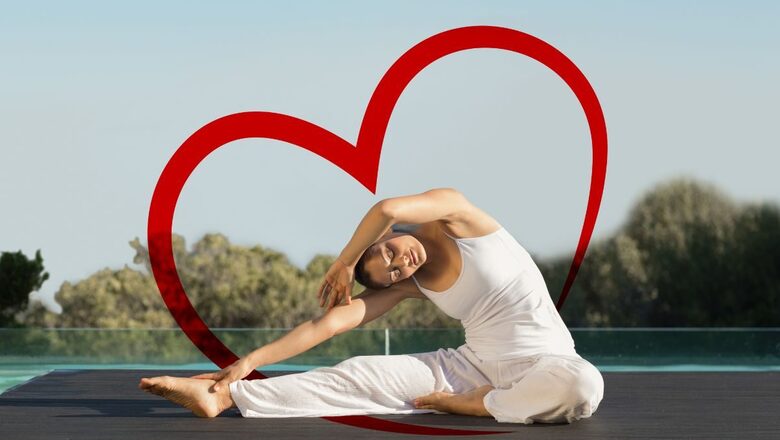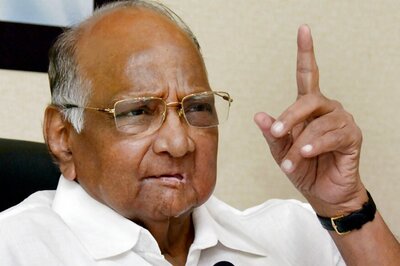
views
We discussed last week how most moderate and severe cases of Covid-19 had shown cardiac involvement, with doctors not ruling it out even in the mild cases. Heart health needs special care and those with conditions like hypertension and coronary heart disease can benefit from our current module.*
YOGA IS ABOUT MODERATION — EVEN IN EXERCISE
That exercise, diet and lifestyle changes, and stress avoidance are factors that help the heart is well known. Despite this knowledge, cardiovascular diseases have been on an exponential rise globally. Ironically, there’s been an increase recently in adverse events triggered by physical exercise.
Yoga, a gentler regimen, has steadily gained endorsement by cardiologists as a supplemental therapy for preventing and halting the progression of heart disease. An integrated Yoga therapy module that can help bypass serious heart conditions includes: a) mild practices for increasing circulation, oxygenation and relaxation; b) the right diet; c) correct routines, with time for rest and recreation, and d) changing attitudes and thinking patterns.
In the first part of this series, we described ‘Sookshma Vyayam’, a safe exercise regimen that keeps the cardiovascular system healthy by increasing circulation, as well as DRT or Deep Relaxation Technique.
Here are four asanas that help with physical revitalization as well as achieving mental calmness. Any two of these can be added to the daily practice of Sookshma Vyayam (subject to individual condition and capacity — and a go-ahead given by your doctor).
Vajrasana or the Thunderbolt pose
This Asana provides fixity of base and gives a feeling of harmony in the body. With the back automatically and effortlessly straight, there is easy energy flow through the spine and this aids meditation. It improves blood circulation in the lower abdomen and aids digestion, and this is the one Asana that can be done after meals . It increases circulation in the upper body — the lungs, the heart and the brain — as blood flow is reduced to the lower part during the pose.
The Steps:
• Sit on the floor on a mat in kneeling position. Place the toes together and carefully lower the body into the seat cavity formed by the heels. Both knees and thighs together, the spine straight, and hands placed on the thighs with palms facing downwards. If necessary, a thin cushion or folded sheet may be placed below the ankle joint for cushioning.
• Relax the shoulders and gazing at a point in front, breathe gently in and out for a few rounds. Close the eyes and watch the breath at the tip of the nose.
• Sit in this position for a few minutes daily, gradually increasing the duration to 10 minutes.
(Note: Those who have arthritis or depression may proceed with caution)
Bhujangasana or the Cobra Pose
The gradual arching of the spine allows the chest and abdomen to expand fully. It tones the muscles in the upper areas, improves circulation and deepens breathing.
The Steps:
• Lie on the abdomen, with arms at the sides and elbows bent, palms facing down and placed near the chest.
• Inhaling, raise the head and take the neck and chest as far back as you comfortably can. In this spinal arch, the upper body is to be raised only up to the navel region. The weight on the hands is to be minimal, and there should be a slight pressure felt in the lower back.
• Do not hold the position or retain the breath.
• Exhaling, come back to the original position; release the hands and place the palms under the head.
• Relax with head turned sideways, resting on the palms (as in Makarasana).
• Repeat 3-4 times
(Note: Those with hernia, pregnancy, peptic ulcers, and hyperthyroid may have limitations doing this)
Setubandhasana or the Bridge Pose
The expansion of the chest in this Asana allows space for the heart to ‘open up’. Blood circulation and oxygen flow in the middle and upper body and the brain are enhanced.
The Steps:
• Lie on your back and fold the knees, keeping the heels close to the buttocks. The feet are to be flat on the ground, with one-foot distance between them. Arms lie along the length of the body, palms facing down.
• Inhaling, lift up the pelvis and then the trunk as much as you can. Do NOT hold the position or retain the breath.
• Exhaling, come down to the starting position and relax.
• Repeat 5 times.
(Note: Those with surgeries of the heart, spine, hip, shoulder, knee; injuries and sprains in the neck and shoulder; spondylitis and hernia may avoid or proceed with caution)
SAVASANA – A RELAXATION POSE TO END THE SESSION
Lying like a corpse reduces the heart rate and blood pressure and cortisol levels. Over a period of time, it leads to reduced anxiety and improved cardiovascular health.
The Steps:
• Lie on your back, face towards the ceiling, and arms and legs relaxed. Lay motionless like a corpse. Close the eyes and follow normal rhythmic breathing.
• Without moving the body, consciously relax each part of the body — from the tips of the toes through the feet, legs, pelvic region, hips, abdomen, chest, shoulders, back, neck, face, right up to the top and back of the head.
• Maintain the relaxed state, continuing the deep abdominal breathing.
• When releasing the posture, gently open the eyes. Turn towards your right side, lying there for a few minutes before getting up.
*Remember, Yoga postures are not a substitute for medicine. Also, they must be done in consultation with a doctor, after having first learnt from a trained teacher.
This is part two of a three-part series on Heart Health. You can read the first part here.
The author is a journalist, cancer survivor and certified yoga teacher. She can be reached at [email protected].



















Comments
0 comment